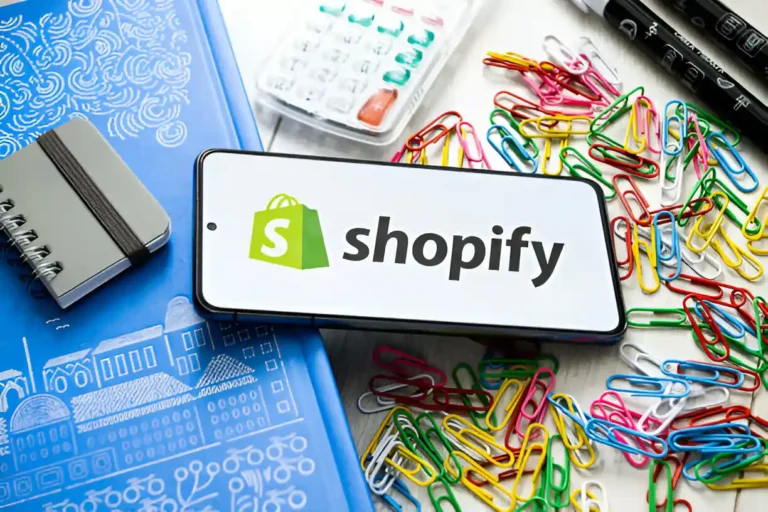Top 11 eCommerce Inventory Management Software Platforms
Recent years have seen incredible growth in the eCommerce market, as we have previously reported. In 2022, retail sales increased by 8.1 percent compared with the previous year, with eCommerce sales accounting for 14.6%. According to eMarketer, eCommerce will increase by 23% in retail sales by 2025. Walmart is one of the largest brick-and-mortar retailers, but it has also acquired a significant online presence.
It is important, however, that you master all the steps involved in inventory fulfillment in order to run a successful eCommerce store (or use a service like Fulfillment by Amazon to do much of the work for you). To help you fulfill your orders and track your inventory items, developers have developed a number of tools and platforms containing special eCommerce inventory management software.
A common feature of eCommerce inventory management software is the ability to purchase stock, identify and track inventory, monitor inventory in real-time, handle online orders, and ship products. It is common for most companies to provide you with monthly reports describing inventory activity and helping you predict your inventory needs in the future.
1. Threecolts
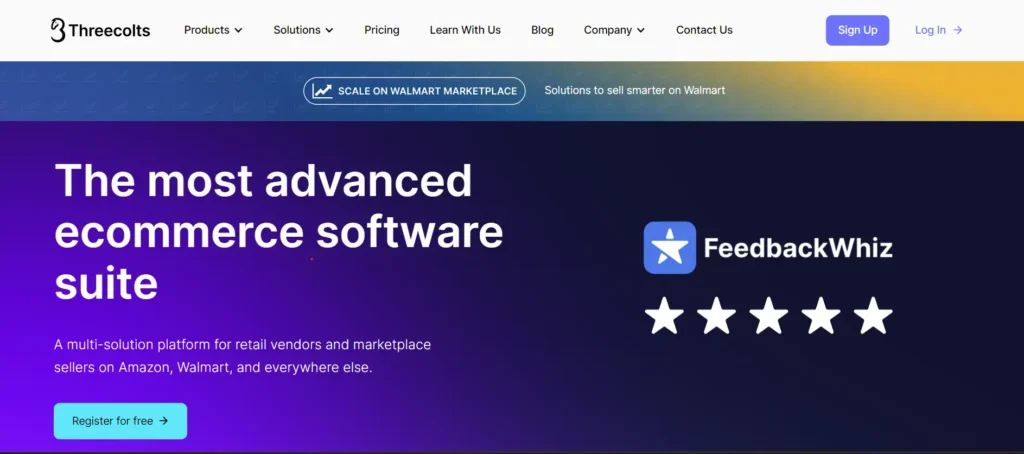
Marketplaces: Amazon Vendor Central, Seller Central, Fulfilled by Amazon (FBA), Fulfilled by Merchant (FBM).
Providing streamlined solutions for eCommerce inventory management, Threecolts offers applications such as DimeThyl and SellerBench for Amazon businesses, which optimize recovery rates, thereby saving businesses over $100 million each year by optimizing recoveries.
Over 2,000 customers benefit from the automated savings and clear insight into inventory-to-cash conversions, which are based on a revenue-based fee of 30% of recoveries. SmartRepricer helps online retailers maximize profits by automating pricing for thousands of products. In order to manage eCommerce inventory efficiently, Threecolts provides customized solutions for every online retailer, regardless of the selling portal or geographic location.
A key component of Threecolts’ suite is FeedbackWhiz, which improves Amazon reviews and feedback scores by automating review generation. There is a 30-day free trial available for this tool, making it accessible to a wide range of organizations.
A platform by Threecolts, ChannelReply, allows e-commerce companies to manage support tickets centrally, enabling them to deliver faster responses to their customers. Additionally, there’s the FW Profit Analytics tool, which gives detailed information about Amazon FBA and FBM profit and loss metrics at the product level.
Additionally, they provide a SmartRepricer tool that automates pricing for thousands of products to maximize profitability and win rates in the buy boxes. This tool offers a 14-day free trial, following which pricing starts at $49 per month.
2. Zoho Inventory

Marketplaces: Amazon, eBay, Etsy, Shopify.
Your sales, marketing, communication, and human relations can all be handled with Zoho’s comprehensive software suite. They offer a range of modules that you can pick and choose from, a variety of apps focusing on specific areas (such as CRM Plus, Finance Plus, Marketing Plus, etc.), or a comprehensive all-in-one suite that can handle everything for your entire company.
The Zoho Inventory system is one of their specialties. It offers six plans as a standalone inventory management system. In addition to a free plan designed for small businesses, the Ultimate Plan is designed for massive eCommerce stores achieving 25,000 orders, shipping labels, and Aftership tracking/month. The Ultimate Plan caters to large businesses with up to 50 orders, shipping labels, and Aftership tracking.
Their order management system lets you manage both your offline and online orders. With their serial number tracking feature and batch tracking feature, you can track every item or batch in your inventory, create purchase orders, backorders, and drop shipments, all in one inventory management app.
You will be able to view real-time shipping rates and in-transit details for major shipping carriers so you can make an informed decision about your shipping partner.
As well as displaying stock levels, managing inter-warehouse transfers, and creating warehouse reports, Zoho Inventory also gives you the option to check stock levels.
As well, Zoho Inventory seamlessly integrates with Zoho CRM and Zoho Books, letting you manage your contacts and orders, and manage sales, purchases, and inventory-related financials at the same time.
3. inflow
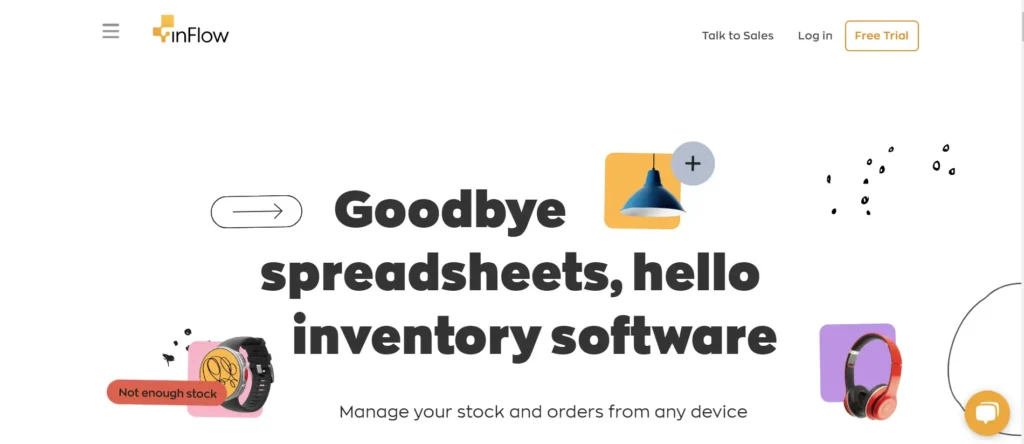
Marketplaces: Shopify, Amazon, WooCommerce.
Inflow is a specialist inventory management software for both eCommerce and traditional brick-and-mortar stores, helping you manage your inventory efficiently. Whether it’s across multiple offices or warehouses, it lets you see where each product is in real time.
All size businesses can find a plan that meets their needs. From the $110/mo. Entrepreneur plan, which is limited to 100 sales orders per month to the $1319/mo. Enterprise plan, which caters to enterprise-sized needs. Inflow’s sales team can prepare a custom plan to suit your needs if the set plans do not work.
Our list of features for Inflow is too lengthy. The software can be used to organize your products, barcode, print and cost, monitor stock, reorder, and keep track of manufacturing inventories. Inflow also interacts with the Purchasing, Sales, and Cash subsystems. It can also be used to build B2B portals that are open and closed.
4. Linnworks
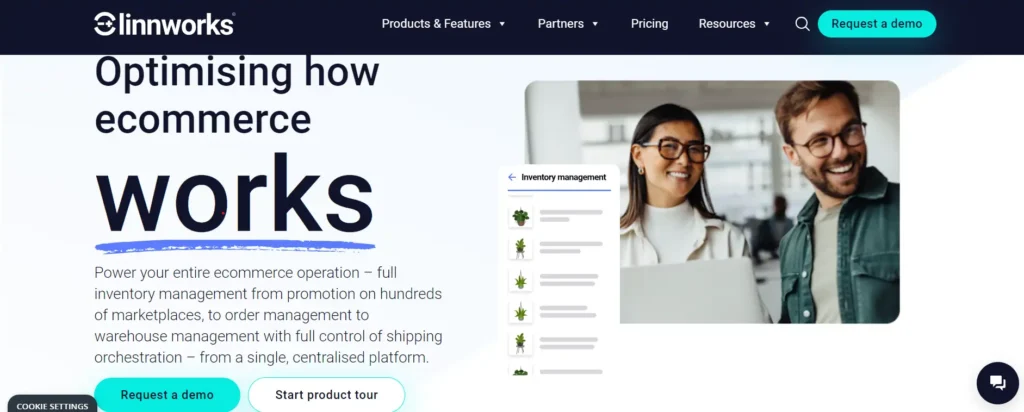
As a SaaS commerce platform that connects business systems, Linnworks assists its users to generate more revenue by offering multiple channels of distribution. Over a hundred integrations, such as Amazon, Walmart, and BigCommerce, are included in the system, which is trusted by thousands of customers.
It’s an excellent choice for B2B brands. Aside from setting B2B prices or discounts, you can also prioritize orders based on business orders. Once orders are dispatched, stock levels will be recalculated automatically.
Besides B2B companies, it has also enabled online businesses to sell across a number of different marketplaces, such as JAF Comics. Their retail store is 10 times bigger than their previous premise, and they have expanded their product range and their physical presence during the last decade by using Linnworks. As a result, they no longer had to worry about missing orders or updating listings individually, which allowed them to achieve this.
5. ShipBob
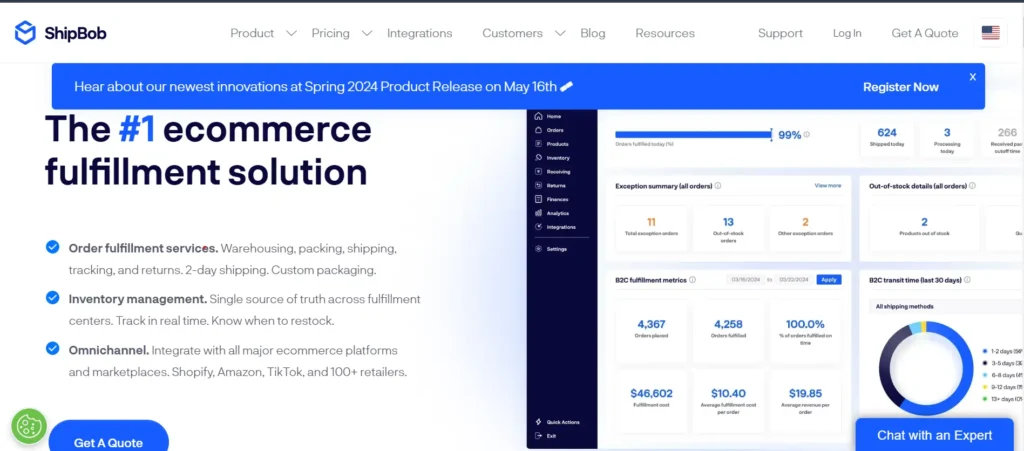
Marketplaces: Shopify, BigCommerce, Amazon, Walmart.
With ShipBob, you can ship orders to more than 220 countries and territories. ShipBob supports global omni fulfillment allowing you to fulfill orders from anywhere.
In order to fulfill your products internally, you have two choices: ShipBob’s warehouse management system (WMS) or ShipBob’s tech-enabled 3PL.
It even has integrated B2B and EDI integrations for retail dropshipping and wholesale distribution. ShipBob integrates with all major eCommerce platforms and marketplaces.
Among the many features of ShipBob WMS, there are warehouse management, inventory management, order management, transportation management, pick and pack, and much more. It makes remote access easy, regardless of where your warehouses are located, because you can use it across multiple warehouses with unlimited users. Additionally, it provides top-level orders fulfillment metrics across all warehouses, counts orders at pickup, packing, and labeling levels, and identifies orders that should be prioritized for fulfillment.
6. Fishbowl

Marketplaces: Shopify, Amazon, Zoho.
Its inventory management solutions are offered both on-premises and in the cloud. Fishbowl caters to a wide variety of businesses, including eCommerce businesses, traditional brick-and-mortar businesses, and hybrid businesses. In the case of manufacturers who need to keep track of raw materials, work in progress, and finished products, Fishbowl can also be used.
Their new cloud-based platform, Fishbowl Drive, provides efficient scanning and barcoding, inventory control and order management, workflow, process traceability, and much more. A new product from Fishbowl, Fishbowl Go, is also being promoted, which the company says will offer their inventory management software at the cheapest price.
In addition to purchasing, inventory management, manufacturing, and sales, the company also offers on-premise software called Fishbowl Advanced. You can manage purchase orders, vendor and client purchase data, and stock receipts. Determine your true cost of goods sold by calculating landed costs that include shipping, duties, and fees.
With Fishbowl, your inventory is accurately tracked, your part and product labels can be customized to meet your specific inventory management needs, and repetitive processes can be automated. Accounting records can be integrated with payments made from point-of-sale systems and eCommerce platforms.
Among the software platforms Fishbowl integrates with are UPS Ready, QuickBooks, Xero, Salesforce, Zoho, and many more.
7. Veeqo
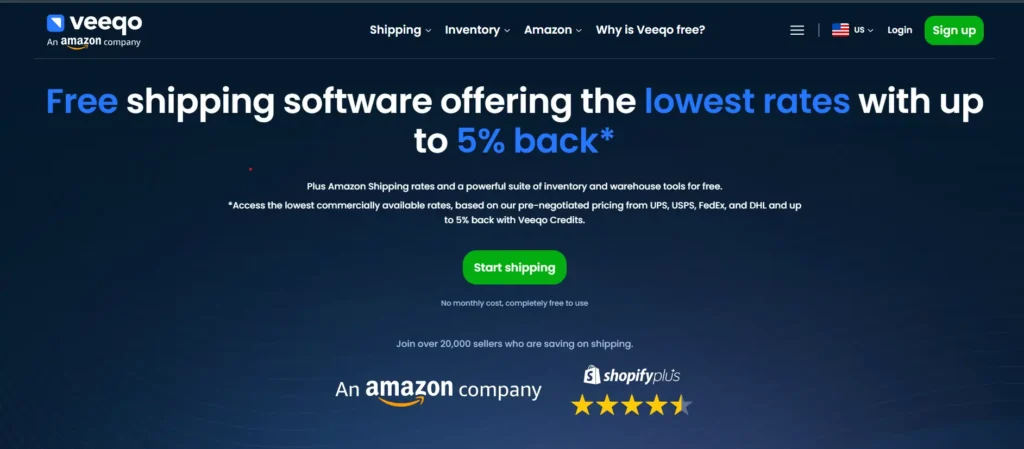
Inventory management tools are available on the market at reasonable prices and some of them are even free. There’s one condition, however, that you have to purchase most of your shipping labels through Veeqo. That makes it one of the most popular tools for eCommerce startups.
As well as Amazon integration, it integrates with Shopify, Walmart, and eBay, which makes it one of the best in the eCommerce world. One of the reasons why it is so great for Amazon sellers is that it is a company owned by Amazon. It’s also completely integrated with Amazon Buy Shipping. The negative feedback associated with that sale will be suppressed if the shipment was delivered on time, but the delivery was delayed.
Veeqo’s inventory management features will let you stay on top of stock movements by automatically tracking all stock items in a centralized area. You will be able to notice quickly as soon as you need to send more stock if you are using Amazon FBA.
8. Trunk

There are many marketplaces available for you to sell on: Amazon, Amazon Handmade, eBay, Etsy, Faire, Shopify, Square, Tundra, and WooCommerce.
Businesses that want to synchronize and manage their stock levels across multiple sales channels in real-time will benefit from Trunk’s inventory management platform. Additionally, several other popular channels are currently being beta tested. No matter where or how you change your stock levels, it keeps them on the same page. An example is shown of someone manually adjusting stock levels on Etsy, receiving an order on Shopify, and refunding an order on eBay. All of it can be synced with the trunk.
Your sales channels’ listings are used to build Trunk’s inventory and stock levels, so you should connect Trunk with the sales channel with the most accurate stock levels. Syncing Trunk’s inventory levels with any new sales channels you connect later will happen once Trunk has its own inventory built.
Currently, Trunk offers two plans that are based on the number of orders you receive. The Essential Plan includes syncing your stock levels to the cloud every day. The Pro Plan includes bundling & kitting, as well as syncing duplicate SKUs.
9. SkuVault
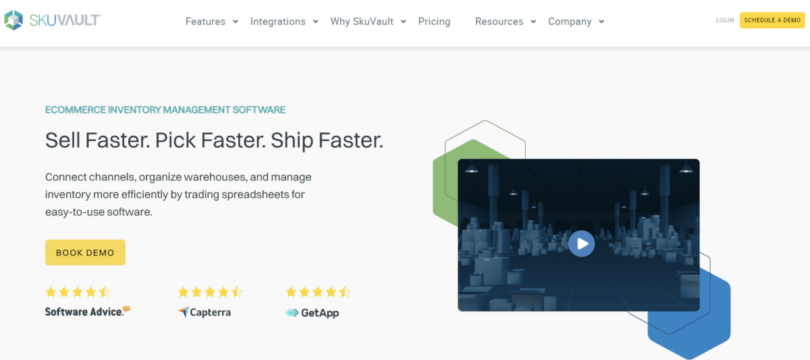
It offers a number of related services, but SkuVault chooses to focus on eCommerce inventory management alone. However, it is also rated as one of the best inventory management tools for Walmart, despite its limited scope. It integrates with Amazon and Walmart, and has been rated among the best inventory management tools for Walmart for years.
It pulls product and order information from the marketplace and creates pick lists with direct routes so that inventory quantity, including inventory in Amazon’s FBA, gets updated in real time. In addition to saving you time, dynamic locations can optimize space usage as well.
SkuVault users include Happy Feet, a family-owned business that sells specialty slippers. It was difficult for them to find a tool for managing several sales channels that their small staff could understand. Their top highlights include SkuVault’s flexibility, user-friendliness, and client support. With these features, they have been able to reduce the time they spend on fulfillment, which has given them more time to grow.
10. Finale Inventory
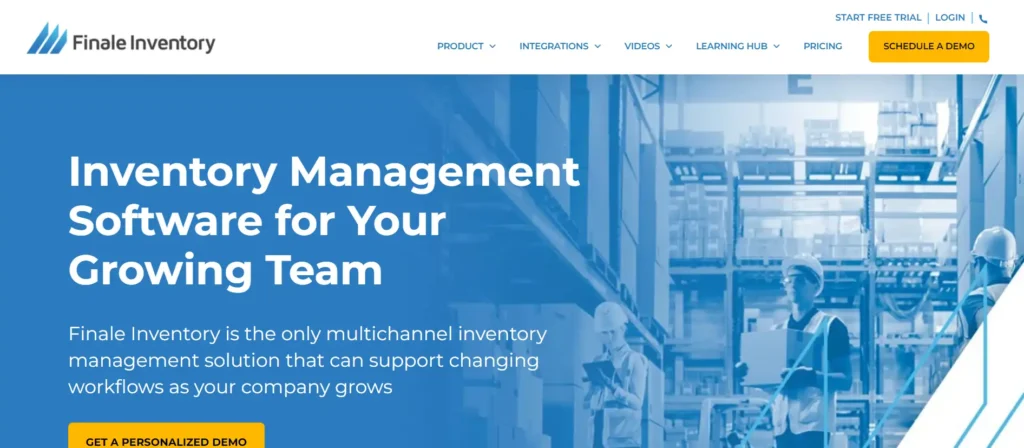
Marketplaces: Amazon, eBay, Shopify.
Multichannel inventory management solution Finale Inventory is designed for eCommerce, warehouse, and high volume applications. As part of its inventory management system, users can manage centralized inventory, integrate multiple channels, scan barcodes wirelessly, warehouse orders, and account for inventory.
All of your products are counted in one place on the platform and your inventory is easily managed across multiple warehouses with this platform. The platform offers more than 40 integrations, so that your marketplace listings are automatically updated by continuously updating the stock levels. When picking orders, you can improve efficiency and reduce costly picking errors by using advanced batch picking methods like wave picking and pick-and-pack.
With Finale, you can manage every shipment that enters or leaves your warehouse. Finale streamlines the ordering, packing, and shipping process, so you can move smoothly from one step to another. With features like multiple shipments and lot identification generation, Finale ensures flexibility.
11. Shiphero

Marketplaces: Shopify, Amazon.
The Shiphero system promises to simplify eCommerce picking, packing, and shipping, allowing you to train recruits faster while picking and packing more in the same time.
Shiphero integrates with Shopify, Amazon, and Returnly easily so you can manage your orders and returns more easily. Your sales channel will always remain in constant communication with Shiphero, which ensures you never run out of inventory. It caters to multiple warehouse and order allocation, POs and receiving, reorder and replenishment level setting, cycle counting, kitting, logs & reports, and putaway.
Orders flow seamlessly to your pickers, packers, and shippers for accurate and efficient processing, thanks to mobile tech. Mobile pick and pack uses mobile technology to make picking faster and more efficient. Fulfillment in your warehouse will be much faster, easier, and more accurate thanks to mobile picking, carrier rate shopping, and bulk shipping.
We always provide the cheapest carrier label thanks to ShipHero’s real-time ship rate shopping.
In addition to real-time monitoring, the Hero Board gives you real-time insight into your warehouse and employee productivity, sales, and accuracy. You can also take advantage of detailed reporting to better manage your business.
Final Thoughts
A seamless inventory management system forms the foundation of a thriving ecommerce operation. Keeping your inventory data safe and accurate is easy when the right software is in your corner. With this compilation, I hope you’ve identified a suitable option, or at least gained enough insight to help you find the best solution for your business.





